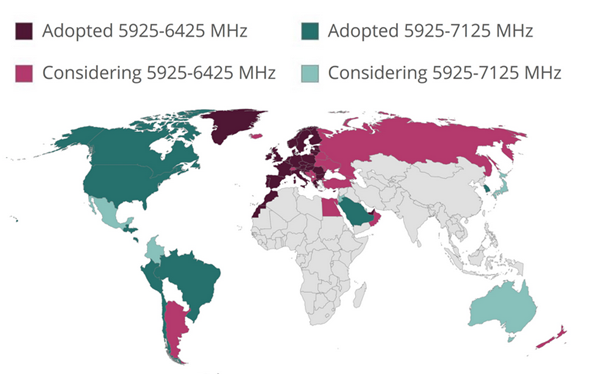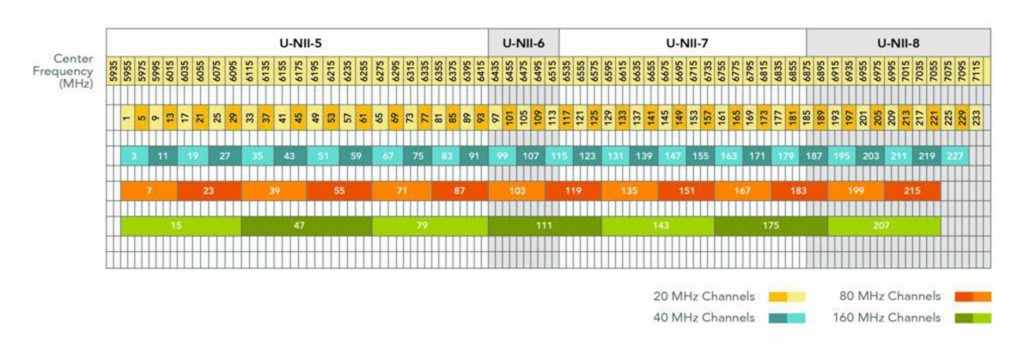In April 2020, the Federal Communications Commission (FCC) allocated 1,200 megahertz of spectrum for unlicensed use in the 6GHz band. That was the largest fleet of spectrum approved for Wi-Fi since 1989. This Opening of the 6 GHz band more than doubles the amount of spectrum available for Wi-Fi, allowing for less congested airwaves, broader channels, and higher-speed connections and enabling a range of innovations across industries. Since the FCC decision to open the 6 GHz band, 70 countries with 3.4B people have approved or have 6 GHz regulations under consideration (Source- Wi-Fi-Alliance)
Currently, as organizations increase their use of bandwidth-hungry video, cope with increasing numbers of client and IoT devices connecting to their networks and speed up their network edge. As a result, wireless networks are becoming oversubscribed, throttling application performance. This frustrates all network users by negatively impacting the user experience, reduces productivity.
Throughout this post, I have tried to cover the basics and the operating rules for Wi-Fi 6E in the 6 GHz band.
What is the “E” in Wi-Fi 6E?
The 802.11ax standard (Wi-Fi 6) also operates in the 2.4 GHz and 5 GHz bands. Due to this, Wi-Fi in the 6 GHz band will be identified by the name of Wi-Fi 6E. This naming was chosen by the Wi-Fi Alliance to avoid confusion for 802.11ax devices that also support 6 GHz. The “6” represents the sixth generation of Wi-Fi and the “E” represents extended.
WI-FI 6E: Increase in number of channels
The 6 GHz band represents 1200 MHz of spectrum that will be available from 5.925 GHz to 7.125 GHz. Knowing that 2.4 GHz band only had 11 channels, with the new spectrum, Wi-Fi will have access to 59 20-MHz channels, 29 40-MHz channels, 14 80-MHz channels, and 7 160-MHz channels. In addition to 2.4GHz and 5GHz, this not only represents a lot of channels, but also a lot of wide channels to operate on high speeds.
Advantage of a huge spectrum
Wi-Fi has always had a very less amount of spectrum. Typically, Wi-Fi had only 80 MHz of spectrum in the 2.4 GHz band and 500 MHz in the 5 GHz band. DFS channel occupy a part of the 500MHz on 5GHz band.
This left very limited contiguous spectrum. It made it difficult to find or enable 80 MHz or 160 MHz channel width, but the maximum Wi-Fi data speeds can only be achieved with these channel widths.
With the 59 20-MHz channels, Wi-Fi 6E will effectively remove congestion issues. At least for the foreseeable future, there will always be at least one 20 MHz channel available without congestion. Thanks to the contiguous spectrum and the 14 80-MHz channels or the 7 160-MHz channels to choose from, a radio will be able to find a channel available, free of congestion. This enables the technology to deliver the highest speeds.
Background on Wi-Fi Standards
Two main groups are responsible for shaping Wi-Fi’s evolution. The Wi-Fi Alliance and IEEE. The IEEE 802.11 defines the technical specifications of the wireless LAN standard. The Wi-Fi Alliance focuses on certification of Wi-Fi devices for compliance and interoperability, as well as the marketing of Wi-Fi technology
Over time, different classifications of Wi-Fi networks were given different naming conventions by the Wi-Fi Alliance. Rather than “802.11b”, it’s just “Wi-Fi 1.” Much like how mobile phone companies refer to 3G and 5G as different network speeds even though the term is almost always just a marketing tool. This classification is supposed to help make it easier for consumers to understand — instead of understanding a whole alphabet soup, users can just look for “Wi-Fi 4” or “Wi-Fi 6” as what they need.
The IEEE 802.11ax standard for high efficiency (or HE) covers MAC and PHY layer operation in the 2.4 GHz, 5 GHz and 6 GHz bands.
IEEE Rules for WI-FI 6E
HE (High Efficiency) only operation in the 6 G
One of the most important decisions made by the IEEE 802.11ax group is that it disallows older generation Wi-Fi devices in the 6 GHz band. This is very important because it means that only high efficiency 802.11ax devices will be able to operate in this band.
Generally, upcoming Wi-Fi standards have always provided backward compatibility with previous standards. This was a boon to customers as well as vendors, since network equipment doesn’t need to be completely overhauled at each new standard. The flip side to this is it will be a source of congestion on the protocol, since legacy equipment is also sharing the available spectrum with the newer devices. In the 6 GHz however, only new high efficiency devices will be allowed to operate.
When using the analogy of road transport to describe Wi-Fi, the 2.4 GHz and 5 GHz band can be compared to congested roads where both fast and slow vehicles travel, while the 6 GHz band is the equivalent of a new, large highway that only allows the fastest cars.
Fast Passive Scanning
With 1200 MHz of spectrum and 59 new 20 MHz channels, a station with a dwell time of 100 ms per channel would require almost 6 seconds to complete a passive scan of the entire band. The standard implements a new efficient process for clients to discover nearby access points (APs). In Wi-Fi 6E, a process called fast passive scanning is being used to focus on a reduced set of channels called preferred scanning channels (PSC). For 6 GHz-only operation, a specific subset of channels will be identified as preferred scanning channels (PSC) where the primary channel of a wide channel BSS should reside, limiting the channels a client needs to scan to discover a 6 GHz-only AP. PSCs are spaced 80 MHz apart, so a client would only need to scan 15 channels
Out of band discovery
Dual-band or tri-band APs operating in the 6 GHz band as well as in a lower band (2.4 GHz or 5 GHz) will be discoverable by scanning the lower bands. In the lower band, APs will include information about the 6 GHz BSS in a reduced neighbour report in beacons and probe response frames. The client will first go into the lower bands, discover the AP there and then move to the 6 GHz band. This will reduce the probe requests that are sent by stations just trying to find APs because it will not be allowed unless it is a PSC channel.
Wi-Fi 6E Channelization
The 802.11ax standard defines channel allocations for the 6 GHz band. This allocation determines the center frequencies for 20 MHz, 40 MHz, 80 MHz, and 160 MHz channels over the entire 6 GHz band. However, regulatory domains specifications take precedence over the IEEE specification and channels that are falling on frequencies or overlapping on frequencies that are not supported in a regulatory domain cannot be used.
AFC and Avoiding Incumbent Users
The FCC defines two types of device classifications with very different transmit power rules. The goal here is to avoid potential interference with existing 6 GHz incumbents. Several classes of APs are being defined to adapt to the U-NII bands and conditions where they will be operating. The standard power (SP) AP and the low power indoor (LPI) AP and very low power (VLP) AP. The low power APs, as the name implies, have reduced power levels since they are only used indoors.
The outdoor, or standard power APs, have a serious potential of interfering with existing 6 GHz users in the geographic area. Fixed satellite services (FSS) used in the broadcast and cable industries might already have a license for the channels in use. Therefore, any new unlicensed users (Wi-Fi) must ensure they do not impact the current services. The answer to this is to create a way to coordinate the spectrum use to avoid interference issues. The basic concept would be that a new wireless device (access point) will consult a registered database to confirm its operation will not impact a registered user. For 6 GHz operation, this is called an Automated Frequency Coordination (AFC) provider.
Standard power APs must use an AFC service to protect incumbent 6 GHz operations from RF interference.
Conclusion
As users connect more and more devices, current wireless airspace will become highly congested, creating resource contention and degrading performance. Migrating to Wi-Fi 6 and Wi-Fi 6E will be critical for infrastructure to meet ever increasing demands users and devices are placing on your wireless networks. WLAN in 6 GHz is a bit different from other bands, and the IEEE tried to leverage the absence of legacy devices in the band.
Hopefully, this information is useful, and piqued your interest.
Check out our Cisco Networking video channel
Subscribe to the Cisco Networking blog








Good overview about WiFi-6E.
Good read!
?
?
I loved the content and the way it is explained. Great job Joseph!
Good explain about Wi-Fi 6E in the 6 GHz band, congratulations !
Ciro Gustavo Mele
Good overview about WiFi-6E. Thanks Joseph
Good overview about WiFi-6E. Thanks Joseph
Clear and useful!
Extraordinary article.
Very good overview on 6E with good insights on fundamentals. Great work Joseph !